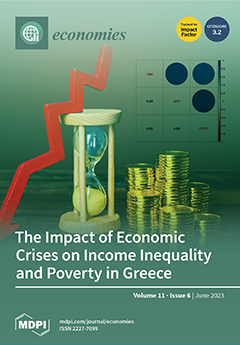Given their increasing engagement with the global economy, emerging countries such as Peru depend on their export sector. This research evaluates the level of efficiency of Peruvian exports (EF) and the impact of four regional trade agreements (RTAs) (MERCOSUR, the EU, the European
[...] Read more.
Given their increasing engagement with the global economy, emerging countries such as Peru depend on their export sector. This research evaluates the level of efficiency of Peruvian exports (EF) and the impact of four regional trade agreements (RTAs) (MERCOSUR, the EU, the European Free Trade Association (EFTA), and the Andean Community of Nations (CAN)), twelve bilateral agreements (BAs), the World Trade Organization (WTO), institutional distance (ID), cultural distance (CD), foreign direct investment (FDI), trade freedom (TF), and traditional (TX) and nontraditional exports (NTX) by sector on the export efficiency of Peru. This non-experimental study used a dataset of 38 countries from 1995 to 2019. An extended stochastic frontier gravity (SFGM) ten-variable model with the one-step estimation method was applied to estimate export efficiency. Poisson’s PML estimator was used to investigate the factors that impact export efficiency (EF). The results showed that the export efficiency of Peru was moderate, ranging between 0.462 and 0.458, with a stationary trend, indicating considerable export potential between Peru and its trading partners. The major contributors to this efficiency are ID (voice and accountability, corruption control, nonadherence to the rule of law), NTX (chemicals and metal mechanics), and BA with American countries. On the other hand, CD (indulgence, long-term orientation, individualism, uncertainty, and lack of a culture of achievement), TF, agreements with MERCOSUR and the EU, FDI, and TX weakened the efficiency of exports. Finally, CAN, EFTA, BA with Asian countries, FDI, TX, and WTO did not have a significant effect on the EF. Recommendations to policy makers are presented.
Full article





